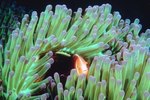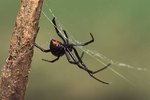
Sea urchins are colorful marine creatures with sharp spines all over their shells. Although the majority of sea urchins don't contain venom—most effects of sea urchin stings are from the puncture wounds caused by the animal's pointed spines—the combination of sting and venom causes wide-ranging effects.
Venom and Spines
Sea urchins known to contain venom are those in the long-spined Diadema and Echinothrix genii and the short-spined Araeosoma, Asthenosoma and Phormosoma genii, as well as the flower sea urchin, Toxopneustes pileolus, which is the most venomous of sea urchins. Long-spined urchins and the Phormosoma species release venom into the puncture wounds their spines create. The Araeosoma and Asthenosoma shoot venom from bulbous sacs at the tips of their spines, barely breaking the victim's skin. Toxopneustes pileolus has pedicellaria, which are biting jaws that contain venom.
Localized Effects
The first sign of a sea urchin sting is intense pain at the puncture site, whether the sting is from a venomous or nonvenomous sea urchin. If venom is present, severe, burning pain may last for hours. Other possible symptoms are warmth, swelling, bleeding and numbness, which may be temporary or, if the sting is from a flower sea urchin, longer-lasting.
Systemic Effects
Toxins from the venom can also cause effects throughout the body, such as nausea, vomiting, muscle paralysis, low blood pressure and weakness. In more severe cases the victim may have respiratory distress or become unconscious. Venomous sea urchin stings can also be fatal, although this is rare.
Long-Term Effects
In most cases, the effects of the sea urchin's venom subside after about six hours, except for the soreness that may remain. Long-term effects are more likely to result from the spines, which easily break off and can remain deep in the wound. Although the tissues heal over the spiny pieces, they can cause symptoms ranging from discomfort to arthritis, bursitis, fasciitis (inflammation of the tissues, blood vessels and nerves) and tenosynovitis (inflammation of the membrane that surrounds tendons). When these conditions cause pain and difficulty of movement, surgery may be necessary. Infections can also occur when pieces of the spines remain in the tissue.
Prevention and Treatment
Sea urchins don't attack humans. Their stings are a natural defense mechanism that occurs when they are handled or stepped on. You can avoid being stung by wearing water shoes, especially in rocky areas where sea urchins hide, and refraining from handling live sea urchins. Scuba divers should be careful not to dislodge them accidentally with their fins. After a sting, visible pieces of spines should be removed. Soaking the wounds in hot water, vinegar or ammonia helps clean the area and coaxes out more pieces of the spines, which causes many of the effects to subside. Seek medical attention for serious stings or long-lasting effects.
References
Photo Credits
-
Jupiterimages/Photos.com/Getty Images
Writer Bio
Barbara Bean-Mellinger is an award-winning writer in the Washington, DC area. She writes nationally for newspapers, magazines and websites on topics including careers, education, women, marketing, advertising and more. She holds a Bachelor of Science from the University of Pittsburgh.




